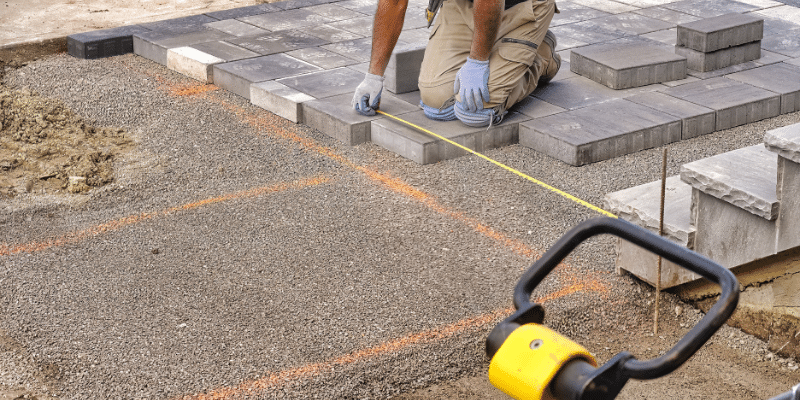hello world!

Whether you're laying down mulch for a garden bed or building a stone pathway, knowing how much material to order beforehand saves time and money. Incorrect calculations can lead to material waste or project delays, so getting it right from the start saves you the headache of scrambling at the last minute.
In this guide, you will learn:
With these tips, you'll be able to accurately determine the amount of landscaping materials you'll need for any project.
The first step in calculating landscaping materials is determining the area where you'll apply the material. The calculations will depend on the shape and size of the area. Here's how to measure for different common shapes:
1. Rectangular or Square Areas:
2. Measure the length and width of the area:
Multiply these two dimensions to get the area in square feet or square meters:
Area = Length × Width
Example: A flower bed that is 10 feet long and 5 feet wide has an area of 50 square feet.
3. Circular Areas:
Measure the radius (half of the diameter) of the circle. Use the following formula to calculate the area:
Area = π × Radius2
Example: A circular garden with a radius of 3 feet has an area of approximately 28.3 square feet.
4. Irregular Shapes:
Break the area into smaller shapes (rectangles, triangles, etc.), calculate each area separately, and then sum them up.
Once the area is determined, you also need to know the desired depth for the material (e.g., 2 inches of mulch). This will be used in the volume calculations in the next step.
Different landscaping materials have unique properties that affect the amount required. Here's how to select the right one for your needs:
Used to level or fill planting areas. Soil typically needs to be calculated in cubic yards or cubic meters, depending on the depth of your project.
Mulch is used for decorative purposes or to retain soil moisture. A typical recommendation is to apply mulch at a depth of 2 to 4 inches. Depth directly impacts the volume required.
For driveways, walkways, or drainage systems, gravel and aggregates are typically calculated based on cubic feet or cubic meters. Keep in mind that some gravel compacts down, which can increase the volume needed.
For paving or decorative accents, stones come in varying sizes and densities. The heavier the material, the more you'll need for an equivalent surface area.
Now that you know the area and material type, it's time to calculate the volume. The formula for volume is simple and depends on the depth you'll apply:
Volume (Cubic Feet) = Area (Square Feet) × Depth (Feet)
Convert the depth from inches to feet before using this formula (e.g., 2 inches = 0.167 feet). For cubic yards, divide the cubic feet by 27, as 1 cubic yard equals 27 cubic feet.
Example:
For a garden bed of 100 square feet with 2 inches (0.167 feet) of mulch:
Volume = 100 × 0.167 = 16.7 cubic feet ≈ 0.62 cubic yards
Different materials require different depth and volume considerations:
For soil, typically used in planting beds, you need about 1 cubic yard of soil to cover 100 square feet at a 3-inch depth. If you need a thicker or thinner layer, adjust the depth accordingly.
Apply mulch at a depth of 2-4 inches. A depth of 2 inches covers about 160 square feet with 1 cubic yard of mulch, while 4 inches will cover approximately 80 square feet.
Gravel is often laid at a depth of 2-3 inches for pathways and patios. One cubic yard of gravel will cover roughly 100 square feet at a 2-inch depth.
For pavers, calculate the number of stones by dividing the total area by the size of each paver. For example, if each paver covers 1 square foot and your project is 200 square feet, you'll need 200 pavers.
Always round up material orders slightly to account for errors or miscalculations. However, avoid overbuying, as this can lead to material waste.
Some materials, like soil or gravel, will settle or compact over time. Account for this by ordering slightly more material than your initial calculation.
For irregularly shaped areas, break them into smaller shapes and calculate each section. This ensures you don't miss or misjudge any part of the project.
Using an online calculator can help double-check your math and ensure you're getting accurate results. Many landscape suppliers may offer calculators on their website where you can input the area and depth to automatically calculate how much material you need.
For a more precise estimate, be sure to use calculators that are specific to the material type, such as mulch, gravel, or soil.
To successfully calculate the amount of landscaping materials you need, remember to:
By following these steps, you'll not only ensure that you have the right amount of materials for your project, but you'll also save time and money.
Next, consider learning more about how to choose the right type of landscaping material based on the specific needs of your project, such as drainage, erosion control, or aesthetic preferences.
Ready to start your landscaping project? Get expert advice and high-quality materials at Hamilton Builders' Supply. Whether you need soil, mulch, stone, or gravel, we have everything you need to bring your ideas to life.
Contact us online or stop by one of our locations to talk to our knowledgeable staff, and let us help you calculate the perfect amount of materials for your project. We service all areas around Hamilton, Burlington, St. Catharines and Hamilton Mountain and Winona.